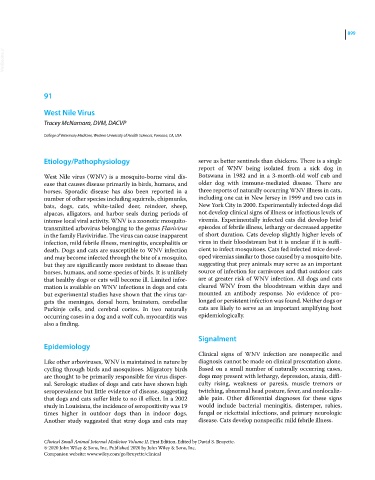Page 961 - Clinical Small Animal Internal Medicine
P. 961
899
VetBooks.ir
91
West Nile Virus
Tracey McNamara, DVM, DACVP
College of Veterinary Medicine, Western University of Health Sciences, Pomona, CA, USA
Etiology/Pathophysiology serve as better sentinels than chickens. There is a single
report of WNV being isolated from a sick dog in
West Nile virus (WNV) is a mosquito‐borne viral dis- Botswana in 1982 and in a 3‐month‐old wolf cub and
ease that causes disease primarily in birds, humans, and older dog with immune‐mediated disease. There are
horses. Sporadic disease has also been reported in a three reports of naturally occurring WNV illness in cats,
number of other species including squirrels, chipmunks, including one cat in New Jersey in 1999 and two cats in
bats, dogs, cats, white‐tailed deer, reindeer, sheep, New York City in 2000. Experimentally infected dogs did
alpacas, alligators, and harbor seals during periods of not develop clinical signs of illness or infectious levels of
intense local viral activity. WNV is a zoonotic mosquito‐ viremia. Experimentally infected cats did develop brief
transmitted arbovirus belonging to the genus Flavivirus episodes of febrile illness, lethargy or decreased appetite
in the family Flaviviridae. The virus can cause inapparent of short duration. Cats develop slightly higher levels of
infection, mild febrile illness, meningitis, encephalitis or virus in their bloodstream but it is unclear if it is suffi-
death. Dogs and cats are susceptible to WNV infection cient to infect mosquitoes. Cats fed infected mice devel-
and may become infected through the bite of a mosquito, oped viremias similar to those caused by a mosquito bite,
but they are significantly more resistant to disease than suggesting that prey animals may serve as an important
horses, humans, and some species of birds. It is unlikely source of infection for carnivores and that outdoor cats
that healthy dogs or cats will become ill. Limited infor- are at greater risk of WNV infection. All dogs and cats
mation is available on WNV infections in dogs and cats cleared WNV from the bloodstream within days and
but experimental studies have shown that the virus tar- mounted an antibody response. No evidence of pro-
gets the meninges, dorsal horn, brainstem, cerebellar longed or persistent infection was found. Neither dogs or
Purkinje cells, and cerebral cortex. In two naturally cats are likely to serve as an important amplifying host
occurring cases in a dog and a wolf cub, myocarditis was epidemiologically.
also a finding.
Signalment
Epidemiology
Clinical signs of WNV infection are nonspecific and
Like other arboviruses, WNV is maintained in nature by diagnosis cannot be made on clinical presentation alone.
cycling through birds and mosquitoes. Migratory birds Based on a small number of naturally occurring cases,
are thought to be primarily responsible for virus disper- dogs may present with lethargy, depression, ataxia, diffi-
sal. Serologic studies of dogs and cats have shown high culty rising, weakness or paresis, muscle tremors or
seroprevalence but little evidence of disease, suggesting twitching, abnormal head posture, fever, and nonlocaliz-
that dogs and cats suffer little to no ill effect. In a 2002 able pain. Other differential diagnoses for these signs
study in Louisiana, the incidence of seropositivity was 19 would include bacterial meningitis, distemper, rabies,
times higher in outdoor dogs than in indoor dogs. fungal or rickettsial infections, and primary neurologic
Another study suggested that stray dogs and cats may disease. Cats develop nonspecific mild febrile illness.
Clinical Small Animal Internal Medicine Volume II, First Edition. Edited by David S. Bruyette.
© 2020 John Wiley & Sons, Inc. Published 2020 by John Wiley & Sons, Inc.
Companion website: www.wiley.com/go/bruyette/clinical

